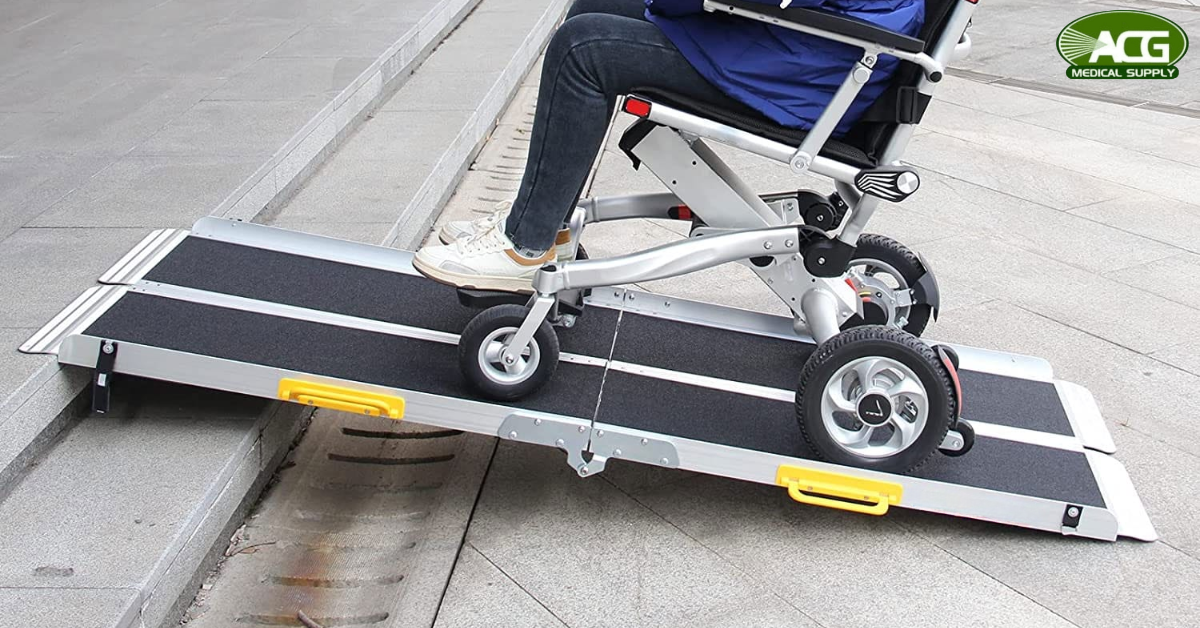Most people don’t wake up excited about buying a ramp. Usually it goes like this: you’ve got a step or threshold that’s become a problem, you search online, and boom — 47 different ramp options with specifications that might as well be written in another language. Let’s fix that. Here’s what you actually need to know about choosing a mobility scooter or wheelchair ramp.
Start Simple: How to measure rise for a ramp?
Here’s where everyone starts. You need to know the “rise” — that’s just the vertical height from ground to wherever you’re going. A doorway, a porch, the back of your van. Grab a tape measure and measure straight up. That’s it.
Write that number down. Inches. Let’s say… 18 inches. That one little number? Yeah, it basically decides everything else. Doesn’t sound exciting, we know. But honestly, we just can’t skip it; it’s the most important part.
The 1:12 rule (And why it matters)
So once you’ve got your rise, there’s this rule that’s very popular and everyone keeps mentioning: the 1:12 rule. Basically, for every inch of height, you need a foot of ramp. So 18 inches up? That’s an 18-foot ramp. And it meets the ADA ramp slope requirements.
The ADA came up with this standard for a reason. That gentle slope means you’re not fighting gravity the whole way up. It means you can control your speed on the way down. If you’ve ever pushed a wheelchair up something too steep, you get why this matters.
Now, some people say “but I don’t have 18 feet of space.” Totally fair. If you’ve got a power scooter, you might be able to go a bit steeper. Like 1:10, 1:8 maybe. Shorter ramp, less space used. But then you’re trading off a little safety and control. It’s a balance.
Width: It’s Not Just a Number
The law says 36 inches minimum. That’s the legal baseline. But here’s the thing — when you’re actually using the mobility ramp, you want more breathing room than the bare minimum. A power wheelchair? A scooter with attachments? Aim for 42 to 48 inches if you can swing it.
Why? Because you need room to move safely. If you drift to one side, you need space to adjust. If you turn too quickly, extra width keeps you from feeling cramped. Those extra inches can make the ramp feel a lot safer.
Oh, and don’t forget about what happens at the top and bottom. You need flat landing space on both ends. That’s where you pause, turn, figure out your next move. It sounds obvious, but a lot of people forget this part.
Pick Your Ramp Type
Not all ramps are the same.
Threshold ramps are small. We’re talking 1-2 inches usually, for doorways and sliding glass doors. Rubber or aluminum, lightweight, affordable. If you just need to get over a door lip, grab one of these.
Portable ramps fold up. Seriously useful if you travel or visit places. Not a permanent solution, but they work when you need flexibility.
Modular ramps are a full commitment. Interlocking pieces that snap together. ACG Medical Supply sells these, and they’re solid. You can configure them for corners, different heights, whatever your space throws at you. They look professional. They last.
Materials: What Works and What Doesn’t
This part’s pretty practical. Different materials behave differently, especially outdoors.
| Material | Pros | Cons | Best For |
| Aluminum | Lightweight, rustproof, durable | Can get slippery without texture, pricier upfront | Outdoor use, modular systems, portable ramps |
| Steel | Incredibly strong | Heavy, rusts without coating | Commercial or high-traffic permanent installs |
| Wood | Looks natural, can be custom-built | Needs sealing every year, can warp or splinter | Custom residential ramps where appearance matters |
| Rubber | Quiet, grippy, absorbs shock | Heavy for its size | Threshold Ramps, indoor transitions |
Making It Work in Real Life
Okay, real scenario. You measure your porch and it’s 24 inches high. The 1:12 formula says you need 24 feet of ramp. Problem is, you don’t have 24 feet of space. Now what?
Option one: Use a steeper slope if the user has a power scooter. A 1:8 slope cuts that down to 16 feet. Still long, but manageable.
Option two: go modular with a turn. Instead of one straight shot, ACG Medical Supply and similar providers can design an L-shaped ramp with a landing in the middle. It takes up less linear space and still meets safety standards.
Or maybe you’re just trying to handle a threshold. In that case, forget the math — grab a 2-inch rubber wedge ramp and call it done. It’s not always complicated.
The key is matching what size ramp for a wheelchair or scooter to the actual user and space. Cookie-cutter advice doesn’t always work.
It Doesn’t Have to Look Bad
Look, there’s a reason people avoid accessibility equipment sometimes. A lot of it looks like it came straight out of a hospital supply catalog from decades ago. That generic institutional vibe nobody asked for.
But that’s changing. Modern aluminum ramps? Clean lines. Look intentional. They blend into a home instead of sticking out. When something looks like it belongs, people feel different about using it. It stops being “the accessibility thing” and becomes just part of your space.
ACG Medical Supply gets this now. Our products meet every technical requirement but don’t scream “medical.”
Conclusion
Get your rise measurement right. Calculate your slope. Pick materials that work where you live. That’s really it. Everything else is just details.
A good ramp means you’re not thinking about logistics when you want to leave your house. You’re just going. That’s the whole point.
FAQs
1. How do I actually measure rise for a ramp?
Measure from ground level straight up to the top of the step or landing. Use inches. That number is your rise.
2. What’s the length I need for a 12-inch rise?
Using 1:12 standard, you’re looking at 12 feet. For a powered scooter at 1:8, you’d get by with 8 feet.
3. Can a ramp elevate home design?
Absolutely. Minimalist aluminum and modular ramps can complement any modern aesthetic.
4. Why does slope matter so much?
Because gravity never negotiates. ADA’s ramp slope requirements keep it in check.
5. Is it possible to use Threshold Ramps indoors?
Yes — they’re perfect for subtle transitions in doorways or uneven flooring.

